So frequent readers saw the Poland culture game, which got a nice fast finish on turn 173 by way of Sacred Sites. I said I could see ways to improve on that game, and this is it.
The first and biggest improvement is to use Brazil instead. I'm absolutely convinced their Carnival ability (double tourism during Golden Age) is the fastest way to go from Sacred Sites to victory. Remember that any multiplier on tourism actually functions at more than its face value. Doubling tourism actually cuts the time to victory by more than half, since the doubling operates on the entire production, not just on the progress towards victory which is tourism minus culture. I'm sure Brazil gets more out of this than Poland does with a few extra policies or France does with theming bonuses that would come way later than Sacred Sites.
For a non Sacred Sites approach, Brazil might be inferior to France, since Carnival can only last so many turns. But I can see how Brazil should be able to maintain the doubled tourism pretty much continuously from Sacred Sites to the end of the game. Poland got that policy on turn 125. Brazil could get it around the same time by trimming one policy from the schedule and culture-bulbing a Great Writer or two. I expect Brazil can just reach victory within 36 turns or so from that, which just takes three golden ages plus Chichen Itza, which can be done with two Great Writers and a social policy.
But here are more improvements to make from the Poland game:
- More ICS. Poland didn't quite get enough cities at 13, they maxed out all the available slots for faith buildings.
- Ceremonial Burial over Tithe. Happy is the limiting factor on ICS, as always.
- Mosques over Cathedrals. This takes some luck to get before an AI grabs Mosques, but also the strategy needs to be to enhance ASAP.
- Don't push food and growth. You can't afford the happy for grown cities, you need it for more cities instead.
- Don't build granaries, you don't need them. Food trade routes are enough.
- Don't go Tradition! You don't need the food.
One challenge to solve with a fast Sacred Sites game is policies. This plan is policy-intensive: you want Liberty to work towards ICSing, Piety for Sacred Sites itself, and Aesthetics is also more important for Brazil because of the Golden Age in that tree and because the Cultural Exchange bonus multiplies with Carnival. But you can't get all of that. I'm looking for a win around turn 160. You get about 12 policies including the Oracle in that time. Of course that isn't anywhere near enough to fill three trees. I can see the following possible plans, on a sliding scale of tradeoffs between best ICS and best endgame performance.
- Plan A: Forget Aesthetics. Fill Liberty (except Representation later), then Piety. This gives the fastest ICS and some happy from Meritocracy to support it, plus the Golden Age at Representation is available right after Sacred Sites. Sacred Sites itself may come a bit too late this way, though.
- Plan B: Left side of Liberty (Republic and Collective Rule), then Piety up to Sacred Sites, then as much of Aesthetics as we can get towards Flourishing of the Arts and Cultural Exchange. This might be the best balanced plan overall, and skips the weak policy of Citizenship. But it misses out on Meritocracy and Representation and gets really tight on fitting in Mandate of Heaven.
- Plan C: Just the Liberty opener and Citizenship, then Piety. This gets Sacred Sites sooner, can fit Mandate of Heaven, and gets access to Representation. But this misses all the good Liberty ICS policies.
- Plan D: Forget Liberty, just go full Piety then full Aesthetics. No ICS helpers at all, but gets Sacred Sites the soonest, and can buy more faith buildings thanks to the Piety finisher providing the enhancement prophet. This is the slowest start but the most powerful endgame, getting to Cultural Exchange the fastest.
One consideration to keep in mind is how Representation works with its cost discount. With 15 cities worth of ICS on a large map (7% extra policy cost per city), Representation works out to discounting back its own cost roughly 4 policies later. Representation making itself virtually free is great -- but this only works if it comes early enough with enough policies behind it to matter, but also it has to come somewhat late because the Golden Age is only any use after Sacred Sites. There's actually quite a narrow window to use this the right way.
Really the problem with this plan is all the deadweight you have to go through to get to the key policies. The Piety opener, Organized Religion, and Religious Tolerance are all quite weak, but you have to plow through them somehow to get to Sacred Sites. The Aesthetics opener, Fine Arts, and Cultural Centers (you don't need to build any of those with Sacred Sites) are also junk blocking your way to the good bits.
Ultimately, for this first attempt, I decided to go with plan A. Full Liberty and Piety, and forget Aesthetics. Let me see how it goes with the strongest ICS and avoiding the Aesthetics deadweight. I can then try to optimize from there.
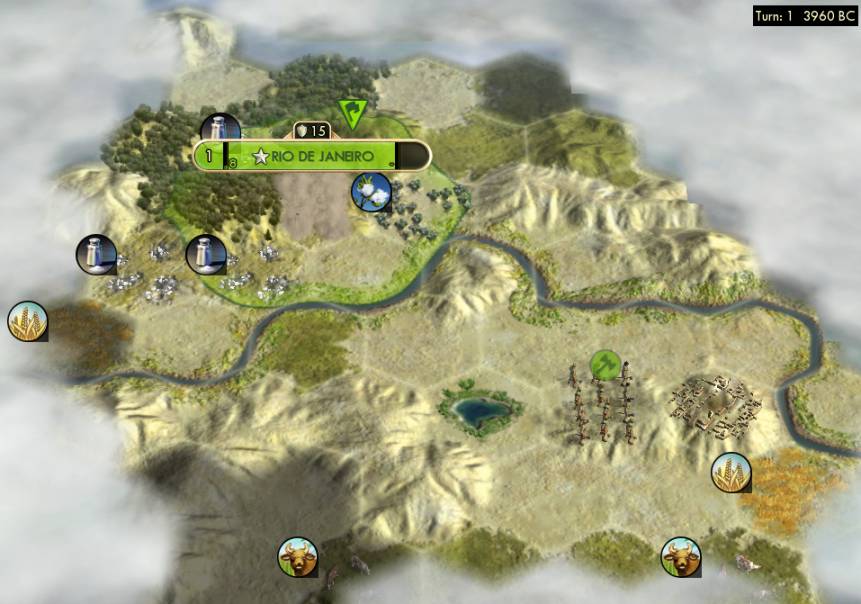
Not as desertastic as some starts, but triple salt is not to be overlooked!
A culture ruin came on turn 5, perfectly timed. Also a spearman upgrade who stayed home for defense, t9 85 gold, t11 Archery, t15 culture again, t17 survivors to size 3, t18 65 gold, t19 culture again!, t22 survivors to size 4, t28 Sailing, t32 survivors to size 6!
Build order: Scout - scout - monument (a Liberty start needs that) - scout. I also bought a scout early, on turn 13. This is unusual, but I wanted to convert the money into play quickly rather than sitting to accumulate. The usual early purchase is a worker, but we had one coming from the Liberty policy, especially when the second culture ruin speeded that up.
Why so many scouts? Because the first warrior-cum-spearman stayed home for defense, and also contributing was this:

Neat, the natural wonder that gives the Altitude Training promo, double movement in hills. Speeds up scouts so it's worth sending out more of them.

Also this: wow, that's the most awkward dead-end I've ever seen! The northern rim of that mountain range touches the inland sea and Attila blocks the western exit. So the only way out is south (by the sheep) and that scout had to backtrack like six turns. This sort of thing is enormously rare on Inland Sea and why I use the map, but still can happen sometimes.
Following build order: shrine - settler - granary (because needed for caravan) - caravan - worker - archer - settler settler settler settler.
Policies: Thanks to culture ruins, I got the Liberty opener on turn 6 followed by Citizenship (the worker) on turn 15. Then t23 Republic, t47 Collective Rule, t64 Meritocracy.
Tech: Mining - Pottery - Bronze (chop the forest on the 3rd salt) - AH (build caravan for 2nd city) - Calendar (cotton) - Masonry - The Wheel for roads. After that, honestly the tech path didn't much matter. I got up to Drama & Poetry for the Writers Guild and Philosophy for the Oracle fairly soon, but there wasn't any particularly tight squeeze on the tech tree. I built the Pyramids, but skipped going for Petra this time around, this capital wasn't good enough for it and couldn't count on another city to finish it fast enough.
Money: turn 19 sold the first salt nice and early, getting 5gpt. T24 second salt sale for 4 gpt. T32 bought second worker, and some time later a settler.
Religion: An unusual start. Thanks to going Mining before Pottery, I got the shrine quite late, on turn 25. But weirdly, nobody had founded a pantheon by then! And I had found one religious CS for the 8 faith, so just two turns of shrine production got me Desert Folklore on turn 26.
After the shrine, on turn 25, the capital started a settler. I hate doing that before the Collective Rule discount... but actually another city and monument is the only way to produce more culture to speed up that policy, short of building a wonder.
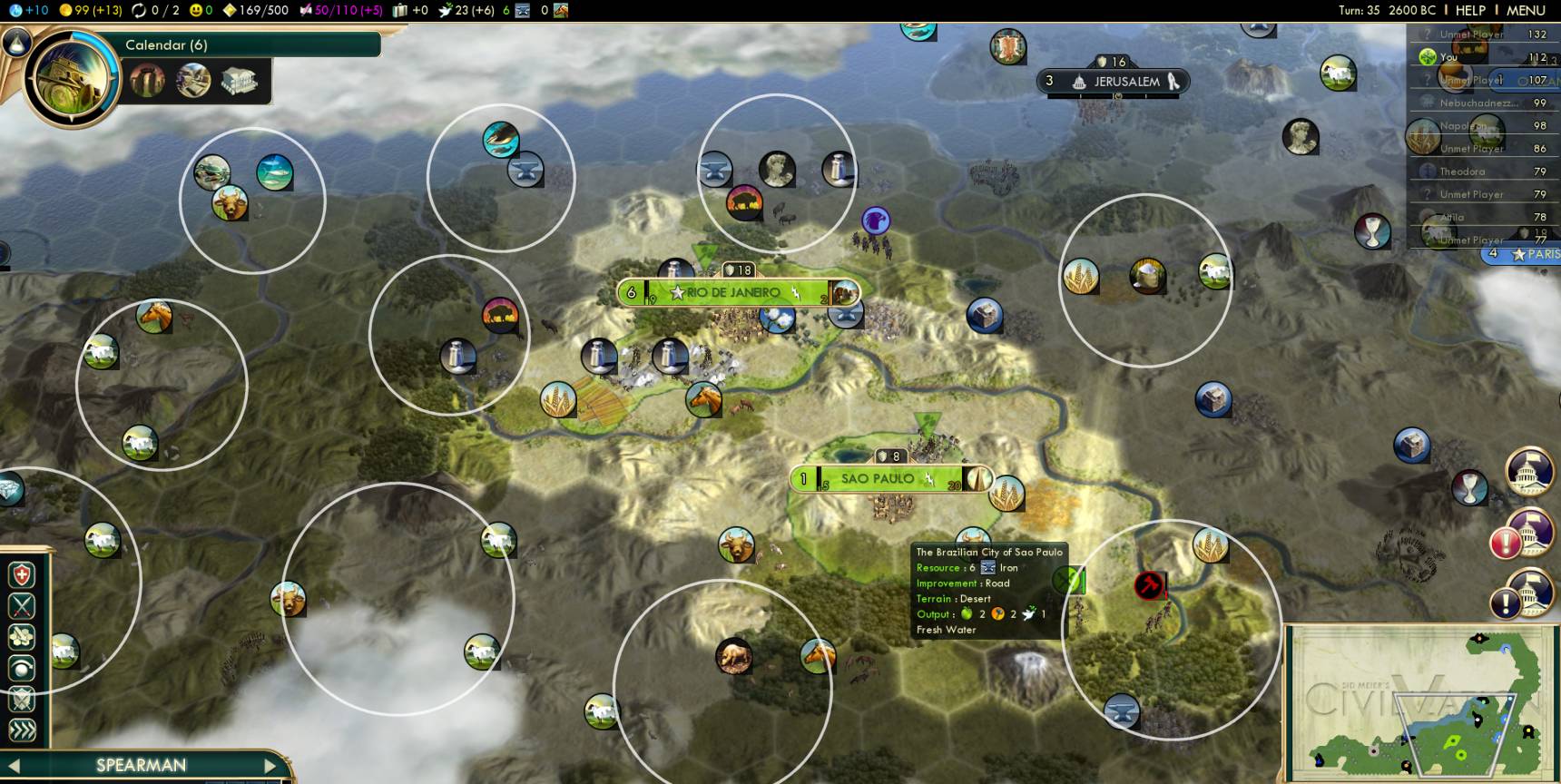
Here's the second city, on turn 35. It has two purposes. One is for Desert Folklore, since the capital isn't working a lot of desert thanks to the salt, but all the good tiles here are desert. Second, it's founded on 6 iron to sell immediately for great profit.
This turned out to be a GREAT map for ICSing. Look at those small clusters of resources all over the place. There's a total of six more unique luxuries within reach, all at good sites with multiple other resources and plenty of hills.
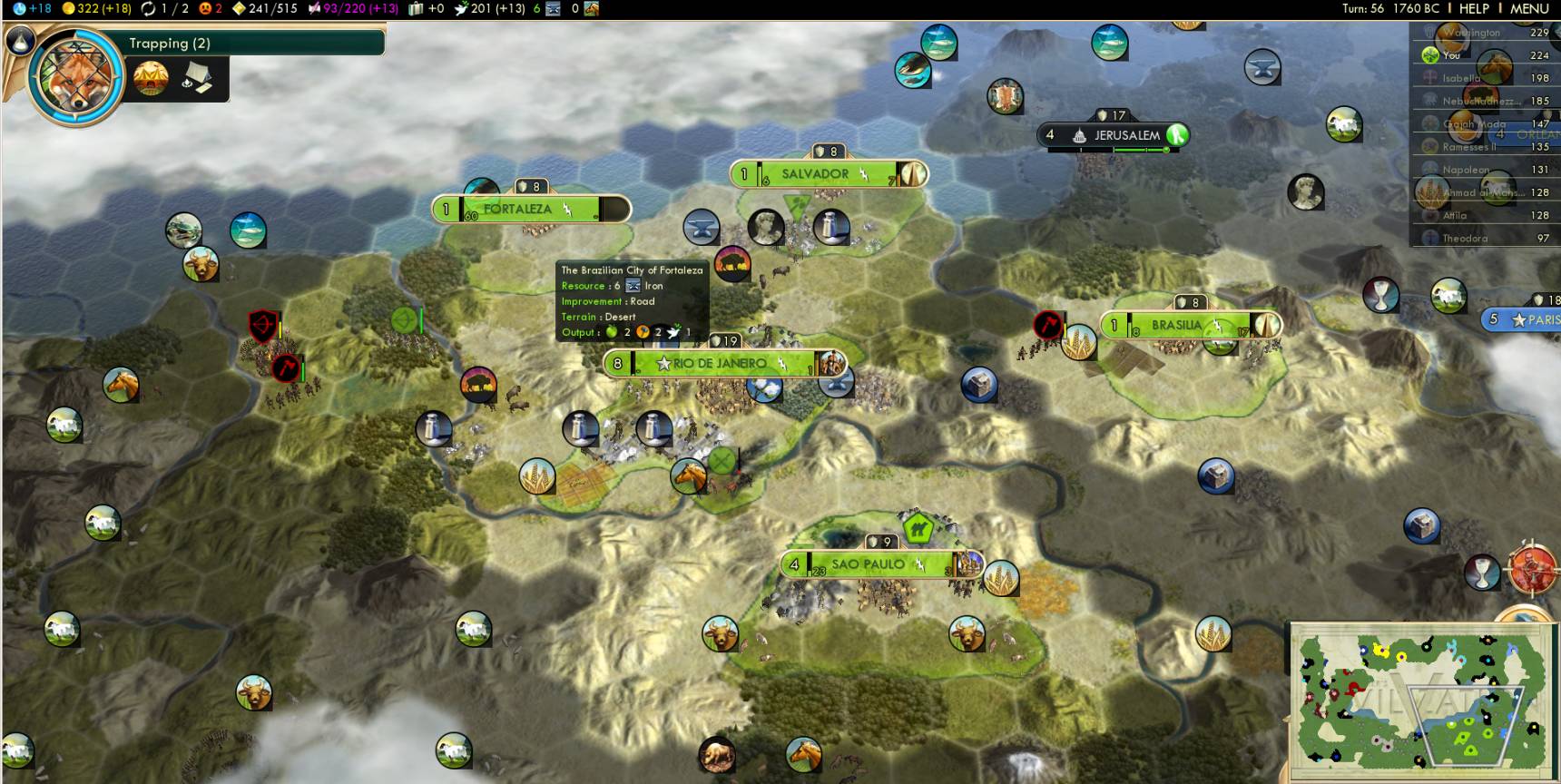
Here we are, just 20 turns later, dropped down three more cities with another settler on the way. Brasilia swiped the sugar before neighboring France could get there. Fortaleza continues the expansion -> resource -> money -> expansion cycle as fast as possible, being founded on 6 iron to sell immediately. Theodora had friended me, and bought my iron for me to buy that work boat for the whales.
You can also see the faith counter over 200. The prophet popped on turn 58, slightly slower than I hoped but still good enough.
You can also see some barbarians. They hit HARD here. I even lost a settler (later recovered) and a trade route to them. The latter actually wasn't too bad as I could rebuild the caravan trade unit as a ship instead.
Most cities went monument - archer to start. Once the barbarians were under control, monument - colosseum was the common opening. Then after the Piety opener, monument - shrine.

As usual, my explorers met at the antipode, and started clearing camps. It takes two units to do this. One archer can't do it alone, because it can't kill the unit and walk into the camp on the same turn, so somebody else will usually swipe it. But one archer plus one scout is usually enough, as here. This was actually a three-for-one, that worker turned out to belong to Malacca.
These mercantile CSes were actually a minor problem, feeding me too much happiness too soon. I couldn't stop the happiness Golden Age, which of course I would have preferred to save for after Sacred Sites. I don't know if it's possible to manage your happiness precisely enough to do that, though. You need to avoid reaching 500 total surplus happy by like turn 125, that means averaging just +4 surplus happy over that entire time, a very tight limbo bar to squeeze under.
I continued to accumulate faith towards the enhancement prophet, hoping that the Mosques belief would last until I could get it. America was second to religion, and took a faith building belief... but Monasteries not Mosques! Spain also founded one... but took Religious Center (temples +2 happy). Then on turn 81, I finally got the prophet (like five turns after my faith counter reached 300), and enhanced with Mosques and Religious Texts as usual.
Meanwhile, the build order at the capital included the Pyramids, but then went settler settler settler settler settler settler settler. My money went into buying workers at most of the new cities. A few dozen turns later, Brazil looked like this:
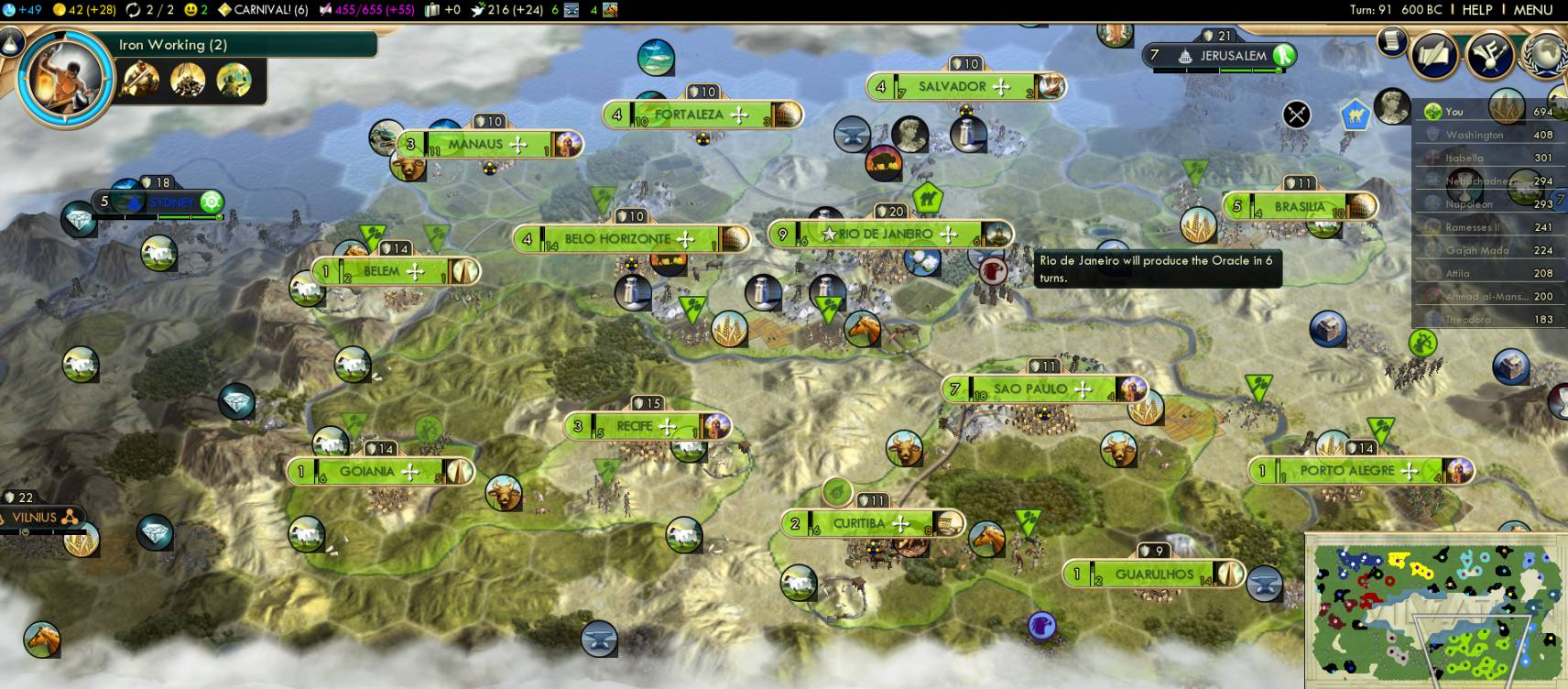
Wow, 13 cities by 600 BC. Yes, the max ICS Liberty plan is working well. At least out to the limits of my available land. I would add one more city in the far west, but other than that, there literally isn't any space for any more. I was kicking myself over the mistake of Porto Alegre's location. At 7 tiles distant from Brasilia, it blocks out that entire flood plains area, so sad to see that great river unused and unsettled. Porto Alegre really needed to be one more tile south to fit in one more city near that stone.
They also all have my religion, despite not using any missionaries! I pulled this trick, that I'd read about on CFC but scoffed at, but it really does work. I held every city beyond the first four at size 1 until it converted by pressure from the capital. This was well worthwhile. It only took much time on the first two such cities (Fortaleza and Manaus), delaying them by about 10 turns of growth. But once they converted, they quickly snowballed the pressure to all the other newer cities. Belem and Recife converted quickly with only a very small delay to growth, and then all that pressure was enough to convert everything else fast, even the larger cities.
One bit that didn't work right was food trade routes. My plan was to cycle them among cities to grow them in the absence of granaries and Tradition. But I smacked down 13 cities way faster than two food routes can supply. But I started realizing that for this plan, you don't need to grow the cities. You don't need food. All they have to do is build the monument and shrine to pull their weight in the culture and faith departments, and then it really doesn't matter if they just sit at size 4 slowly building a colosseum. I even sent one trade route off for a city-state quest instead.
Faith production is also going a bit less well than I hoped. 24 faith production here is lower than I wanted, thanks to idiotically not settling on most of that floodplains river. And I don't have a whole lot more desert coming, maybe 20 more tiles, where Poland had well over 50. But I just got up to buying my first Pagoda, and so faith would ramp up that way. (Faith production is also low right at the moment thanks to Brasilia, which was in that stupid state where the pantheon followers got outnumbered so it lost the pantheon but hasn't gained the religion yet, it should be contributing 6 worth of Desert Folklore.)
The one city that did get a food trade route was Recife, which also received the first pagoda. Why here? Because it has both the most desert hills to claim with culture, and the need to grow because it has a mountain to build Machu Picchu.
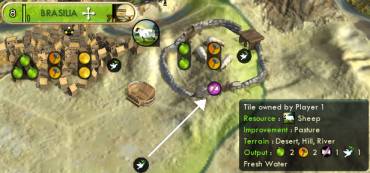 Policies into Piety: t80 opener. t95 Mandate of Heaven, yes it did look like we had enough time to squeeze that in. t98 Organized Religion via Oracle. t109 Religious Tolerance.
Policies into Piety: t80 opener. t95 Mandate of Heaven, yes it did look like we had enough time to squeeze that in. t98 Organized Religion via Oracle. t109 Religious Tolerance.
Amusingly, for the second consecutive culture game, I had a neighbor with the pasture-culture pantheon and got to use that in a border city.
Noting for future reference: the Liberty then Piety plan moved through the Piety policies at about 14 turn intervals, information to use for scheduling other approaches through the policy trees. The Liberty opener is doing significant work here, still accounting for about 20% of my civ's total production and a couple turns per policy.
Tech went to Civil Service for the food and Chichen Itza, then Guilds for Machu Picchu and the Artists Guild. Theology came late; you don't need it in this plan. Also built Colossus just because I could.
I had previously taken care to prioritize the tech and build for the Writer's Guild, and got my first Great Writer on turn 103. Here was a key move: spend him for a culture bulb rather than a great work. I was hoping for a win date in about 50 turns. So as a great work with the Carnival multiplier, he could be worth up to 200 tourism over the 50 turns. Getting Sacred Sites 8 turns sooner would actually also be worth just about 200 tourism. But the culture bulb was a better idea since it also brings forward all following policies, particularly Representation for the Golden Age.
So now we started buying faith buildings, and look what happened:
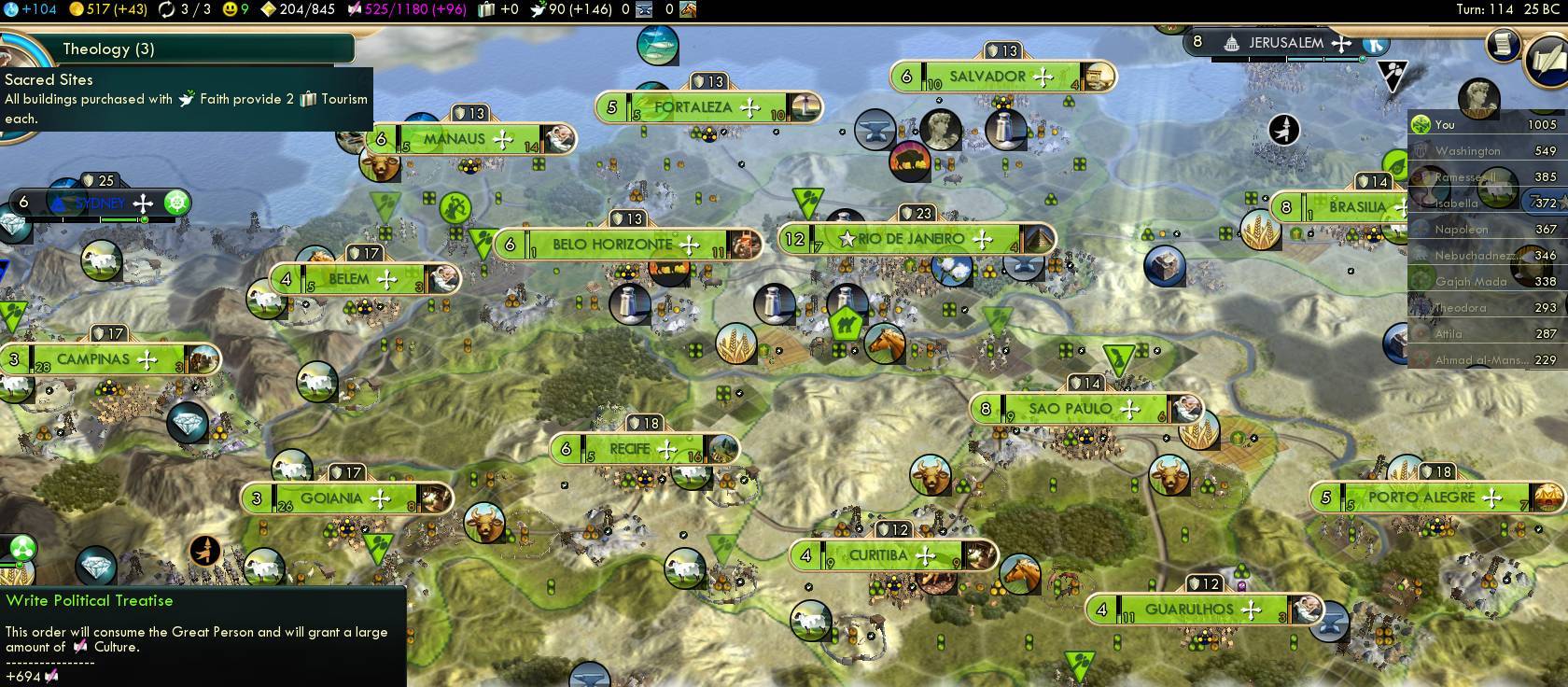
Holy crap. We exploded up to 150 faith production just 23 turns after the first pagoda! This is what can happen when you skip granaries and get to the business bits sooner. Each city went monument - shrine - temple.
I quickly realized that Mosques should be bought over Pagodas when you're not happy constrained, for the extra faith production. And somehow even in this ICS game, I never really crashed into the happy cap. I had a cushion of about 10 happiness most of the time. My Brazil is at almost a mosque every turn, creating happy faster than the cities can grow to consume it. Skipping granaries was again a key here - don't grow population, it just gets angry.
Where did that 150 faith come from? Pretty much evenly balanced from everywhere. About 40 from Desert Folklore, about 40 from regular shrines and temples, about 40 from the mosques, and some spare change from religious CS and assorted wonders.
The picture shows Chichen Itza close to completion, but I actually missed it by one turn. But that would actually turn out not to matter, read on.
And this picture is just as I culture-bulbed that Great Writer into Sacred Sites. We got it on t114 25 BC, actually even faster than mighty Poland did, thanks to skipping one policy in Liberty then the writer bulb. With this explosive start, the victory must be close at hand, right?
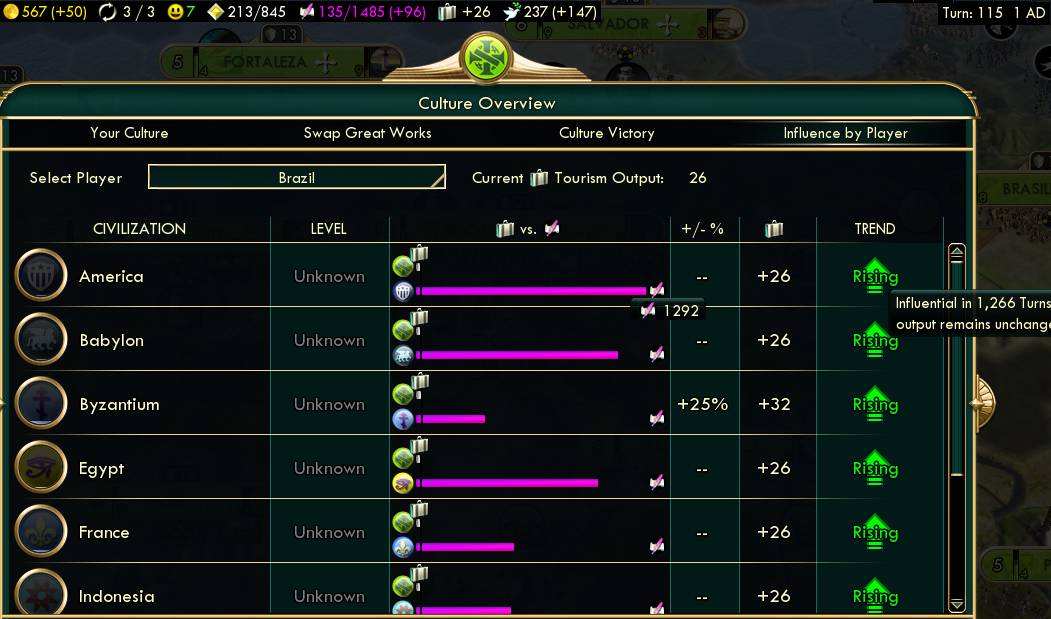
Heh, okay, there's still some work to do.
I skimmed over the math for tourism in the previous reports, but let's take the deep dive now.
First, see how we can work out a civ's culture production exactly from the information shown here. The equation goes like this. C is the civ's total historical culture, CPT is their culture per turn, N is the turns remaining, T is my total historical tourism, TPT is my tourism per turn. Influential status is reached when your current plus future tourism equals their current plus future culture.
T + N × TPT = C + N × CPT
All these factors are shown on this screen except CPT. Solving algebraically and rearranging the terms yields:
CPT = TPT + (T - C) / N
In America's case here:
CPT = 26 + (26 - 1292) / 1266 = 25
We now know America is producing 25 culture per turn. I'm outproducing them by just 1 unit, which accounts for the numbers shown, it will take 1266 turns to close the 1266 gap between their culture and my tourism. But with this equation and these values, we can project any hypothetical scenario. Let's see what happens if we apply the Carnival modifier of double tourism so that TPT is 52, and let N be the unknown variable to see how long the victory date now would be.
N = (T - C) / (CPT - TPT)
N = (26 - 1292) / (25 - 52) = 46.9
Carnival alone would reduce my win horizon from 1266 turns to 47. As I mentioned up top, doubling the offense accounts for much more than doubly better results. Carnival doubles the entire offense and not just the margin of offense minus defense. 47 turns is already just about within the horizon of turn 150 that I hoped for, but of course, we're going to do even better than doubling, as I'm less than halfway there on buying all the Sacred Sites buildings.
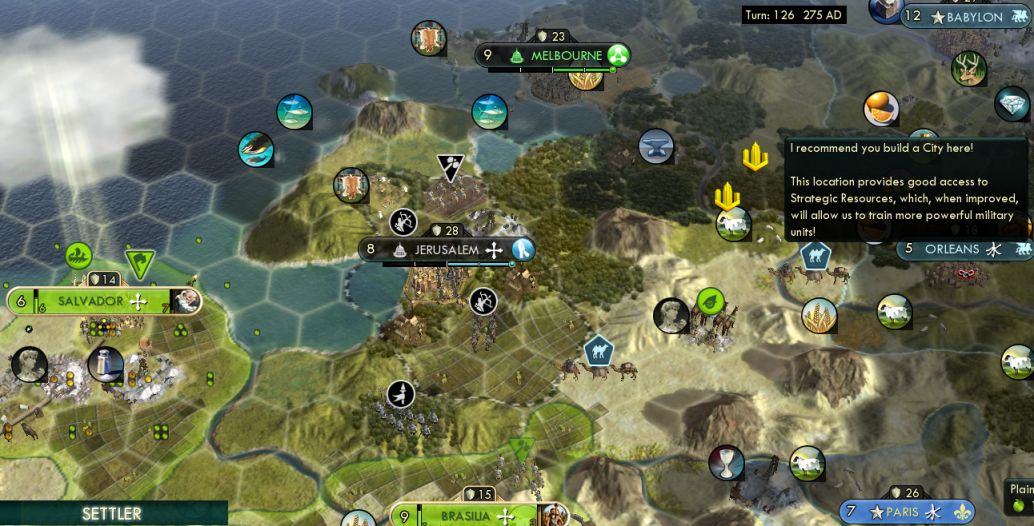
Presently I realized that the necessary build order after temples was more settlers. Dump them anywhere you can. If there's no room at home, walk them twenty turns and settle into the teeth of neighboring Attila or Babylon. Angering them doesn't matter one bit, we'll win the game before he can raise anything to attack, or even if he does, we don't even care if we lose a city or two. The single paramount consideration is getting more slots in which to buy mosques and pagodas. Looks like the game even knows this, suggesting in that picture that this settler go cram into that jungle there.
On turn 128, we'd accumulated the culture for the Representation policy, and our Golden Age Carnival started. Now let's check the end date:
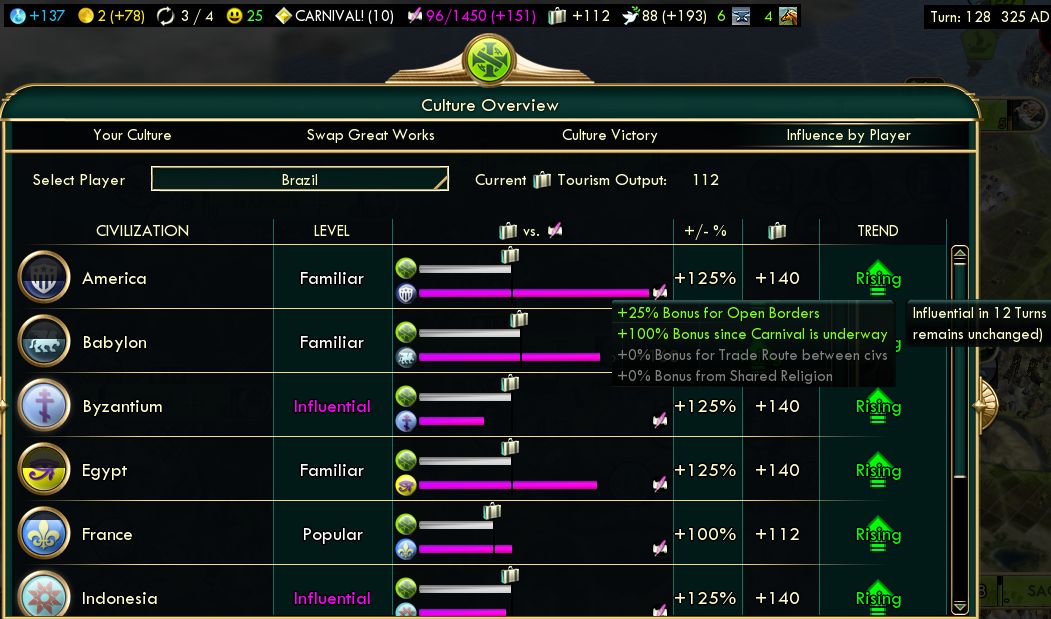
Wow. This screen misled me for a bit: I thought that Carnival actually applied twice, since this screen shows both the base doubled and a +100% multiplier. That's not true, since this screen actually lies. There is no +125% multiplier. The base is doubled and then the +25% for Open Borders applies (which is shown correctly in the tourism column), but there is no +100%. The screen is just a bit overeager in displaying the Carnival bonus that has already been applied into the base tourism.
But anyway, yeah, 12 turns to the end date is far faster than I'd foreseen in any calculation. This came from just adding ever more faith buildings, up to 240 faith for 1.5 pagodas or mosques every turn.
The Representation policy also means the Liberty finisher, free great person. So the best thing I could do with that was take a Great Musician. He couldn't possibly make it to America within 12 turns, but could tour a nearby civ and the splash tourism would shave off one turn. And this is why missing Chichen Itza didn't matter, we'd just win within these 10 turns.

I shaved off a couple more turns with the Great Musician, more faith buildings, and even one Great Work from a writer. Culture Victory on turn 136 520 AD.
That was crazy fast, but oh yes, we can go faster.